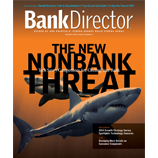
Honest Abe is not impressed.
A team of Swiss economists claim that the business of banking makes industry employees more dishonest.
“Our results suggest that the social norms in the banking sector tend to be more lenient towards dishonest behavior and thus contribute to the reputational loss in the industry,” says Michel Maréchal, Professor for Experimental Economic Research at the University of Zurich.
I take the conclusions of this study with a heaping dose of salt: Much of the results center on the employees of ONE BANK, and I have strong reservations about a study that is so influenced by the culture of one company. Frank Eliason, global director of the client experience team at Citigroup, expresses similar concerns–and makes an excellent point about the very real reputation damage the industry has witnessed due to some very bad eggs.
And that’s very true. According to Edelman, the financial services industry remains the least trusted industry globally. American sentiments trend with those worldwide–almost half say that there’s not enough regulation of financial services–but here’s a silver lining: Trust of financial institutions has grown in the past year.
One of the Swiss study’s authors, Alain Cohn, thinks some type of Hippocratic oath for bankers would address the issue.
If an oath like this were supported with a corresponding training program in ethics and appropriate financial incentives, this could lead bank employees to focus more strongly on the long-term, social effects of their behavior instead of concentrating on their own, short-term gains.
I’ve met bankers from all across the U.S., and I have a hard time buying that they’re inherently more dishonest than those in any other industry. But both Eliason, in his post, and the Swiss study’s authors (in a roundabout way), allude to the importance of culture. In Bank Director‘s own research, we’re seeing this more and more as a common theme, with the 2014 Compensation Survey underscoring the importance of culture in attracting talent and the 2015 Bank M&A Survey revealing the challenges bank boards and management face in integrating the purchased bank into the surviving institution–and this includes the bank’s culture. Bank Director Editor Jack Milligan wrote recently about the importance First Financial Bankshares CEO Scott Dueser places on culture, concluding:
And you can’t provide great customer service if your employees hate their jobs, which is why First Financial places so much emphasis on training, career management, empowerment, recognition and, yes, compensation.
It’s probably an axiom that only happy employees can provide great customer service, just like the best milk comes from contended cows. So if customer service is one of your core business strategies, make sure your bank is providing an environment where people enjoy coming to work every day and love what they do.
Eliason, I think, makes a similar point:
…it has to do with experiences we, as an industry, have created for Customers. Change must happen, and it must happen now! Stop worrying about studies, or even these headlines, but instead focus on your Customer, and they will return the favor. The fact is Customers are people and our business has always been about relationships. It is time we concentrate on those relationships.
Banking isn’t evil, and many bankers aren’t dishonest. But negative public perception of the industry is very real. Positive customer experiences–the result of an ethical, client-friendly and employee-friendly culture– will go a long way in restoring trust in the banking system.






 As shared in
As shared in 



